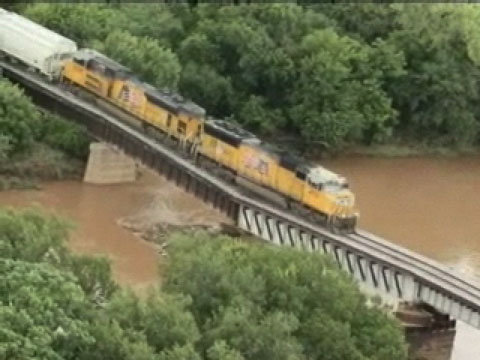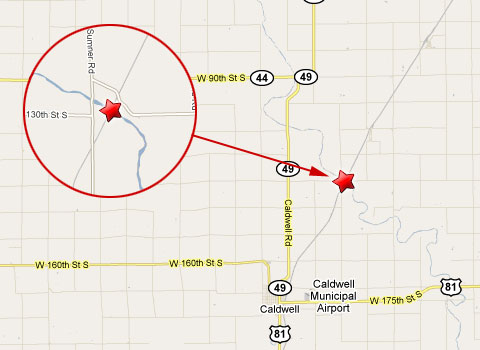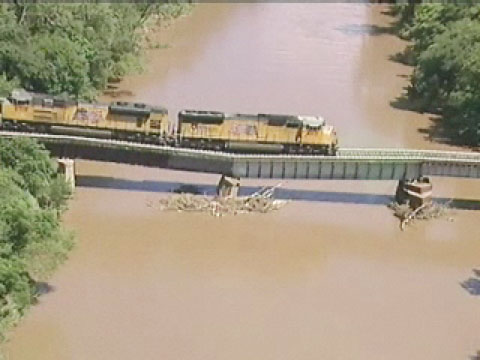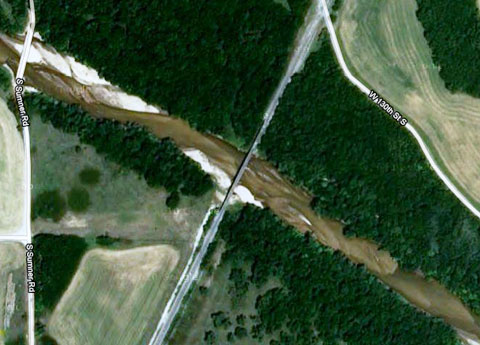CALDWELL, KS – A Union Pacific train was stuck on a sagging bridge over the Chikaskia River on Tuesday, June 15, 2010 in southern Sumner County just a few miles northeast of Caldwell and about 13 miles southwest of Wellington, Kansas.

Union Pacific train with 66 cars and two locomotives were stranded for hours on a bridge over the Chikaskia River just north of Caldwell Kansas
Caldwell is in Sumner County, Kansas in the southern central part of the state near the Oklahoma border about 28 miles southwest of Wellington, about 248 miles southwest of Kansas City, about 60 miles southwest of Wichita and about 193 miles southwest of Topeka.
The southbound 66-car train was carrying hazardous materials. The train sat for hours while the community kept its eye on the water supply. There was some concern because the water supply in the area comes from an aquifer that is fed partially by the river.

Location of the trestle over the Chikaskia River just north of Caldwell, Kansas
There were concerns over possible contamination from hazardous materials. The engine carried thousands of gallons of diesel fuel and one of the cars was carrying anhydrous ammonia.
The trouble started late Tuesday morning. The train crew noticed that something was wrong. They saw the bow in the bridge and then stopped the train. They got off the train and were able to get to safe ground. Railroad crews responded swiftly to the situation.
Two of the train’s 66 cars and two locomotives were stopped on the slumping bridge. The second locomotive and all the cars were stranded behind the bowed section of the bridge.
The initial concern was that the trestle would collapse and drop the train into the Chikaskia River. It could have been a catastrophe, considering that there were hazardous materials involved.

Another view of the stopped locomotives on the sagging trestle over the Chikaskia River
Another train was brought in to assist. Railroad officials worked quickly. They secured the hazardous material and then removed the train from the sagging bridge. The plan was to separate the two locomotives and then pull them off the trestle in opposite directions using the other locomotives. The first locomotive on the original train was disconnected and the remaining locomotive and all the cars were pulled backwards out of danger. Then the first locomotive was sent forwards across the trestle onto safe ground.
Officials said that the rail car that was carrying anhydrous ammonia was never on the bridge. The train car that was carrying the anhydrous ammonia was 18 to 20 cars back from the bridge. The car was secure and there was no leakage.
In the end the river was out of danger and the train was safely removed from the bridge, but it was a tense day. It was not a sight one would see every day. A train was stopped on a trestle that looked ready to collapse.
Fortunately, no railroad workers were injured in the mishap. The crew was able to safely get off the train.
Below is a satellite view of the bridge and the surrounding terrain near the Chikaskia River.

Satellite view of the tracks and the bridge over the Chikaskia River in Caldwell , KS
The cause of the incident is not known at this time, but weather is certainly being looked at.
Heavy rains may have contributed to the situation. Union Pacific representative Tom Lange said that their weather data showed about 8 1/2 inches of rain in the last few days. He said that it was a possibility, but it wasn’t determined fully at this point.
One of the smaller support beams beneath the track apron was missing. That was what caused the track to bow.
In the meantime, train traffic would be re-routed until the bridge could be repaired. It is not clear how long that will take. Union Pacific said that there were typically about eight trains per day that use that route.
Published by fela lawyer Gordon & Elias, LLP